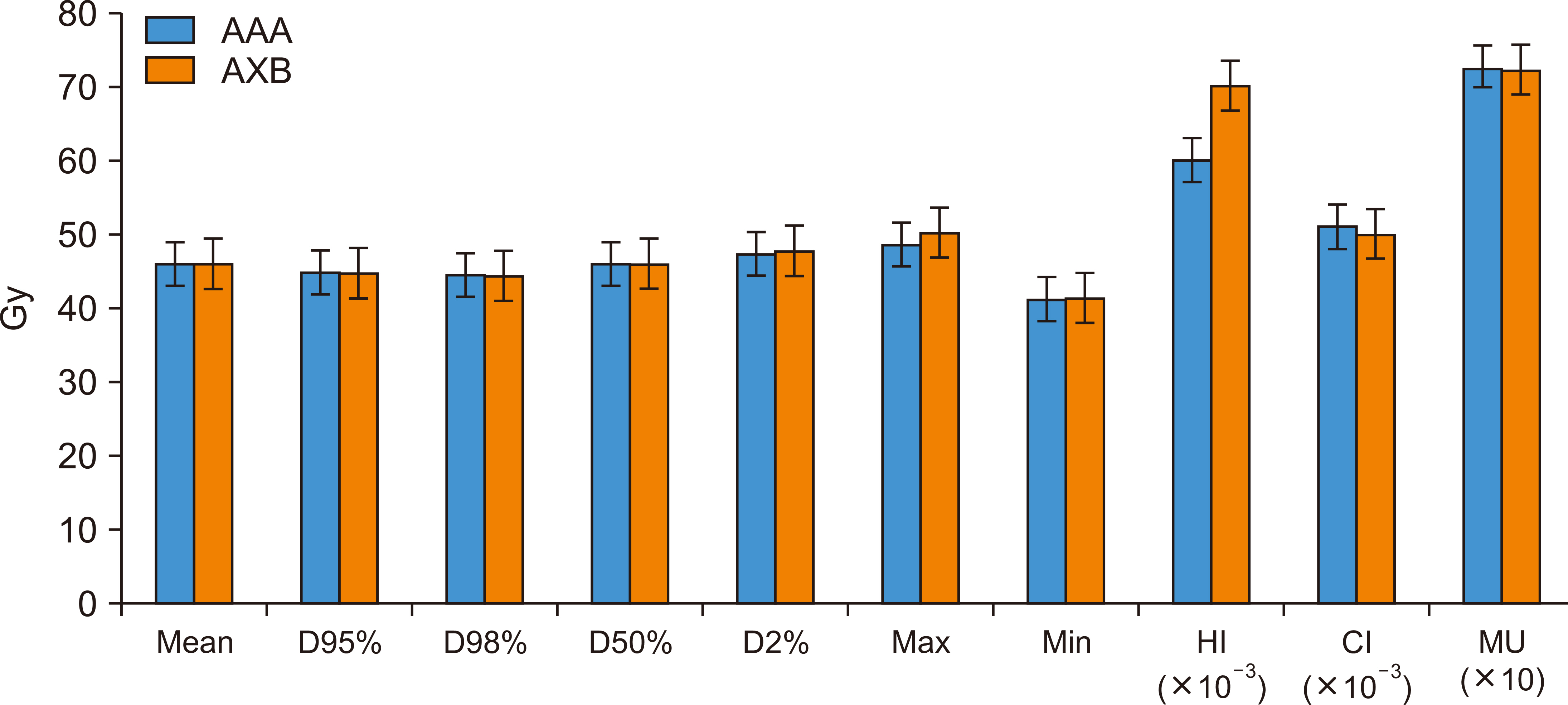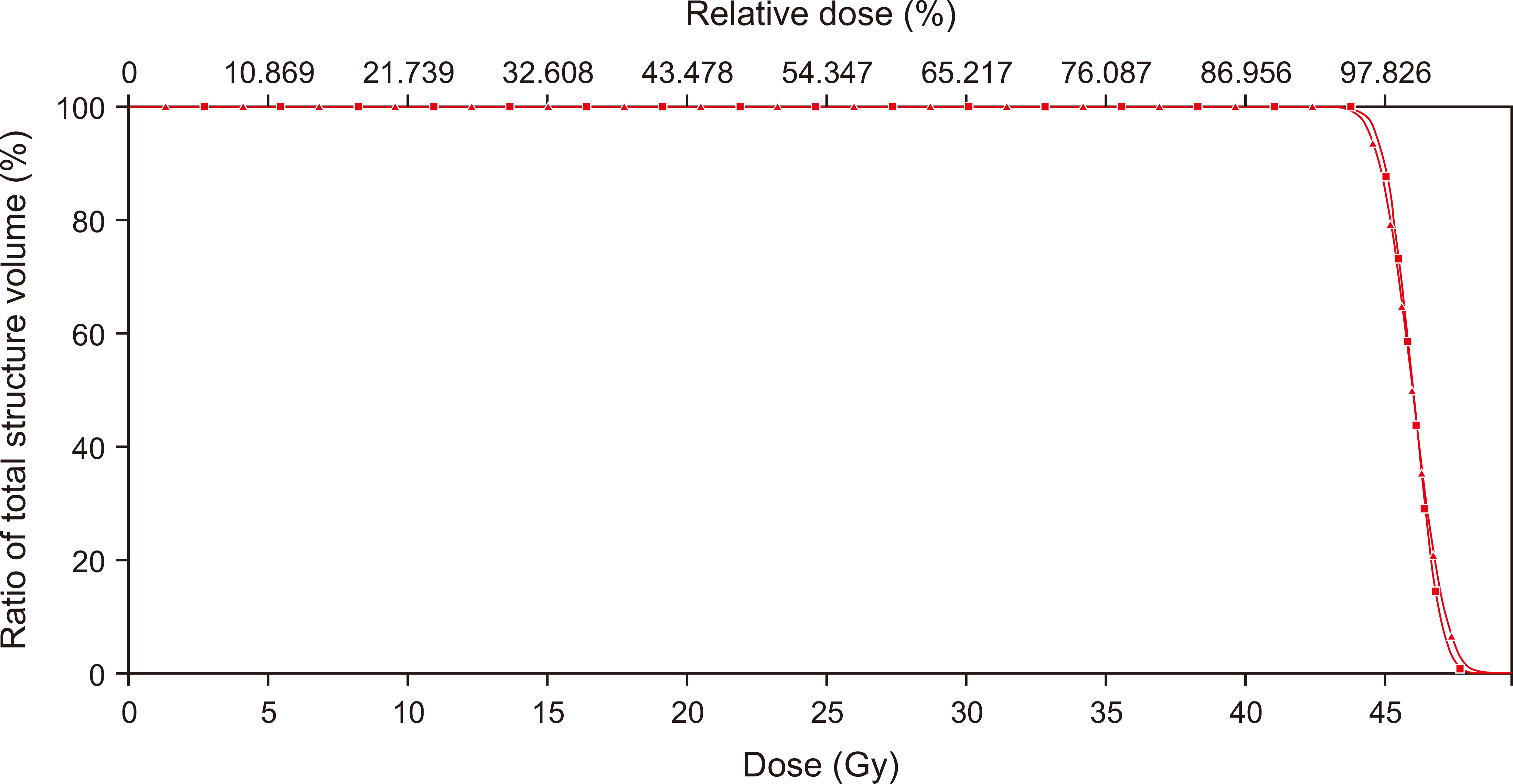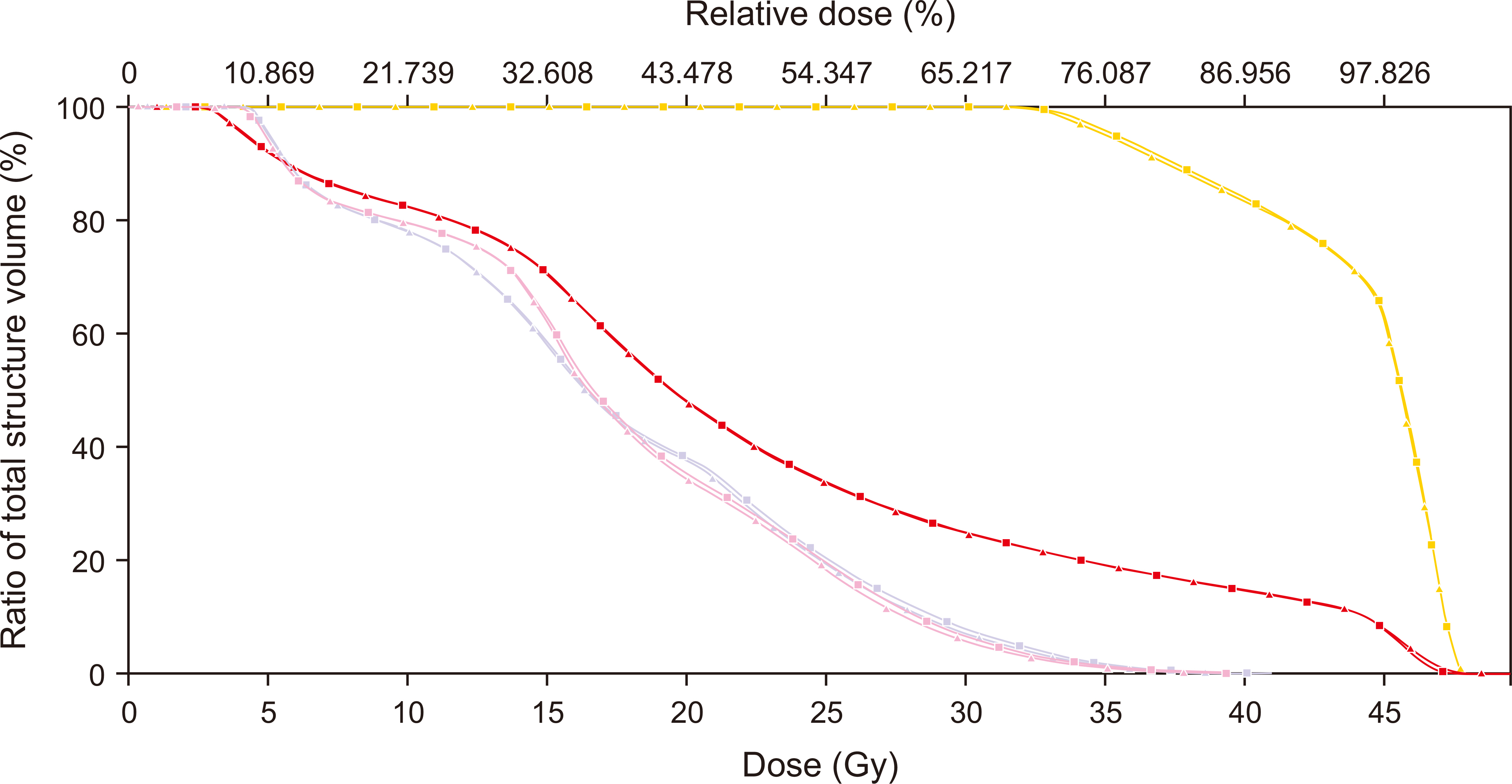Prog Med Phys.
2021 Dec;32(4):130-136. 10.14316/pmp.2021.32.4.130.
Dosimetric Comparison between Varian Halcyon Analytical Anisotropic Algorithm and Acuros XB Algorithm for Planning of RapidArc Radiotherapy of Cervical Carcinoma
- Affiliations
-
- 1Division of Medical Physics, Groote Schuur Hospital, Cape Town, South Africa
- KMID: 2524159
- DOI: http://doi.org/10.14316/pmp.2021.32.4.130
Abstract
- Purpose
The Halcyon radiotherapy platform at Groote Schuur Hospital was delivered with a factory-configured analytical anisotropic algorithm (AAA) beam model for dose calculation. In a recent system upgrade, the Acuros XB (AXB) algorithm was installed. Both algorithms adopt fundamentally different approaches to dose calculation. This study aimed to compare the dose distributions of cervical carcinoma RapidArc plans calculated using both algorithms.
Methods
A total of 15 plans previously calculated using the AAA were retrieved and recalculated using the AXB algorithm. Comparisons were performed using the planning target volume (PTV) maximum (max) and minimum (min) doses, D95%, D98%, D50%, D2%, homogeneity index (HI), and conformity index (CI). The mean and max doses and D2% were compared for the bladder, bowel, and femoral heads.
Results
The AAA calculated slightly higher targets, D98%, D95%, D50%, and CI, than the AXB algorithm (44.49 Gy vs. 44.32 Gy, P=0.129; 44.87 Gy vs. 44.70 Gy, P=0.089; 46.00 Gy vs. 45.98 Gy, P=0.154; and 0.51 vs. 0.50, P=0.200, respectively). For target min dose, D2%, max dose, and HI, the AAA scored lower than the AXB algorithm (41.24 Gy vs. 41.30 Gy, P=0.902; 47.34 Gy vs. 47.75 Gy,P<0.001; 48.62 Gy vs. 50.14 Gy, P<0.001; and 0.06 vs. 0.07, P=0.002, respectively). For bladder, bowel, and left and right femurs, the AAA calculated higher mean and max doses.
Conclusions
Statistically significant differences were observed for PTV D2%, max dose, HI, and bowel max dose (P>0.05).
Figure
Reference
-
References
1. Arbyn M, Weiderpass E, Bruni L, de Sanjosé S, Saraiya M, Ferlay J, et al. 2020; Estimates of incidence and mortality of cervical cancer in 2018: a worldwide analysis. Lancet Glob Health. 8:e191–e203. DOI: 10.1016/S2214-109X(19)30482-6.
Article2. Jordaan S, Michelow P, Richter K, Simoens C, Bogers J. 2016; A review of cervical cancer in South Africa: previous, current and future. Health Care Curr Rev. 4:1000180.3. Delaney G, Jacob S, Barton M. 2004; Estimation of an optimal radiotherapy utilization rate for gynecologic carcinoma: part I--malignancies of the cervix, ovary, vagina and vulva. Cancer. 101:671–681. DOI: 10.1002/cncr.20444. PMID: 15305396.4. Otto K. 2008; Volumetric modulated arc therapy: IMRT in a single gantry arc. Med Phys. 35:310–317. DOI: 10.1118/1.2818738. PMID: 18293586.
Article5. Nguyen D, Pietri FJ, Sporea C, Khodri M. 2018; Patient Quality assurance of the new halcyon linear accelerator (Varian). Phys Med. 56(Suppl 1):10–11. DOI: 10.1016/j.ejmp.2018.09.030.6. Smilowitz JB, Das IJ, Feygelman V, Fraass BA, Kry SF, Marshall IR, et al. 2015; AAPM medical physics practice guideline 5. a.: commissioning and QA of treatment planning dose calculations- megavoltage photon and electron beams. J Appl Clin Med Phys. 16:14–34. DOI: 10.1120/jacmp.v16i5.5768. PMID: 26699330. PMCID: PMC5690154.7. Sievinen J, Ulmer W, Kaissl W. 2005. AAA photon dose calculation model in EclipseTM. Varian Medical Systems;Crowley:8. Vassiliev ON, Wareing TA, McGhee J, Failla G, Salehpour MR, Mourtada F. 2010; Validation of a new grid-based Boltzmann equation solver for dose calculation in radiotherapy with photon beams. Phys Med Biol. 55:581–598. DOI: 10.1088/0031-9155/55/3/002. PMID: 20057008.9. Akpochafor MO, Aweda MA, Durosinmi-Etti FA, Adeneye SO, Omojola AD. 2014; Simulation of the Linear Boltzmann Transport Equation in modelling of photon beam data. IOSR J Appl Phys. 5:72–86. DOI: 10.9790/4861-0567286.10. Bedford JL. 2019; Calculation of absorbed dose in radiotherapy by solution of the linear Boltzmann transport equations. Phys Med Biol. 64:02TR01. DOI: 10.1088/1361-6560/aaf0e2. PMID: 30524016.
Article11. Kumar L, Kishore V, Bhushan M, Kumar P, Chaudhary RL. 2021; Dosimetric impact of Acuros XB on cervix radiotherapy using RapidArc technique: a dosimetric study. Rep Pract Oncol Radiother. 26:582–589. DOI: 10.5603/RPOR.a2021.0074. PMID: 34434574. PMCID: PMC8382073.
Article12. Bhagaloo V, Bhim N, Hunter A, Fakie N. 2021; A dosimetric comparison of volumetric modulated arc therapy with three-dimensional conformal radiotherapy in the treatment of cervical cancer. South Afr J Oncol. 5:a149. DOI: 10.4102/sajo.v5i0.149.
Article13. Aoyama H, Westerly DC, Mackie TR, Olivera GH, Bentzen SM, Patel RR, et al. 2006; Integral radiation dose to normal structures with conformal external beam radiation. Int J Radiat Oncol Biol Phys. 64:962–967. DOI: 10.1016/j.ijrobp.2005.11.005. PMID: 16458781.
Article14. Social Science Statistics. T-test calculator for 2 independent means. Social Science Statistics,;Available from: https://www.socscistatistics.com/tests/studentttest/default2.aspx. cited 2021 Jul 22.15. Kry SF, Feygelman V, Balter P, Knöös T, Charlie Ma CM, Snyder M, et al. 2020; AAPM task group 329: reference dose specification for dose calculations: dose-to-water or dose-to-muscle? Med Phys. 47:e52–e64. DOI: 10.1002/mp.13995.
Article
- Full Text Links
- Actions
-
Cited
- CITED
-
- Close
- Share
- Similar articles
-
- Dosimetric Validation of the Acuros XB Advanced Dose Calculation Algorithm for Volumetric Modulated Arc Therapy Plans
- Comparison of Anisotropic Analytic Algorithm Plan and Acuros XB Plan for Lung Stereotactic Ablative Radiotherapy Using Flattening Filter-Free Beams
- Dosimetric Evaluation of Acuros XB for Treatment Plan on Multiphasic Contrast Enhanced CT
- Dosimetric Analysis of Lung Stereotactic Body Radiotherapy Using Halcyon Linear Accelerator
- Comparison of Dose Distributions Calculated by Anisotropic Analytical Algorithm and Pencil Beam Convolution Algorithm at Tumors Located in Liver Dome Site






